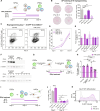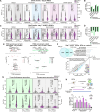The interferon γ pathway enhances pluripotency and X-chromosome reactivation in iPSC reprogramming
- PMID: 39110794
- PMCID: PMC11305397
- DOI: 10.1126/sciadv.adj8862
The interferon γ pathway enhances pluripotency and X-chromosome reactivation in iPSC reprogramming
Abstract
Reprogramming somatic cells into induced pluripotent stem cells (iPSCs) requires activation of the pluripotency network and resetting of the epigenome by erasing the epigenetic memory of the somatic state. In female mouse cells, a critical epigenetic reprogramming step is the reactivation of the inactive X chromosome. Despite its importance, a systematic understanding of the regulatory networks linking pluripotency and X-reactivation is missing. Here, we reveal important pathways for pluripotency acquisition and X-reactivation using a genome-wide CRISPR screen during neural precursor to iPSC reprogramming. In particular, we discover that activation of the interferon γ (IFNγ) pathway early during reprogramming accelerates pluripotency acquisition and X-reactivation. IFNγ stimulates STAT3 signaling and the pluripotency network and leads to enhanced TET-mediated DNA demethylation, which consequently boosts X-reactivation. We therefore gain a mechanistic understanding of the role of IFNγ in reprogramming and X-reactivation and provide a comprehensive resource of the molecular networks involved in these processes.
Figures






References
-
- Mak W., Nesterova T. B., de Napoles M., Appanah R., Yamanaka S., Otte A. P., Brockdorff N., Reactivation of the paternal X chromosome in early mouse embryos. Science 303, 666–669 (2004). - PubMed
Publication types
MeSH terms
Substances
LinkOut - more resources
Full Text Sources
Molecular Biology Databases
Research Materials
Miscellaneous

